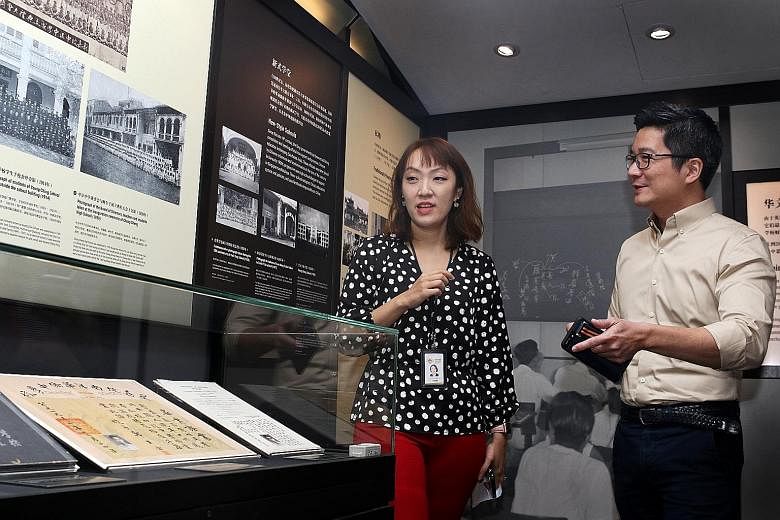Pioneer philanthropist Tan Tock Seng is best remembered for his donation of $5,000 towards the building of the first hospital for the poor in Singapore in 1844.
Originally named the Chinese Pauper Hospital, it is now known as Tan Tock Seng Hospital.
Anyone keen to learn more about how he rose from a humble vegetable seller to become one of Singapore's most eminent philanthropists and a leader of the Chinese community can do so at the newly revamped permanent Gallery 4 - Chinese Business Pioneers in the Sun Yat Sen Nanyang Memorial Hall (SYSNMH).
Tan is just one of 23 Chinese business pioneers featured in the revamped gallery. Only five were featured previously.
"The new gallery seeks to acknowledge and showcase the leadership and contributions of local Chinese business pioneers, and, through their stories, we hope to distil and instil their values in our visitors, provide more relatable role models for our younger generation, and encourage more Singaporeans to put these values into action," said Mr Alvin Tan, 47, deputy chief executive for policy and community at the National Heritage Board.
Tan Tock Seng's contributions exemplify the value of altruism as he was well known for his generosity and compassion towards the less fortunate, said Ms Jermaine Chua, a curator at the SYSNMH.
"We believe that the Chinese business pioneers demonstrated values such as integrity, loyalty, altruism and innovation in their business dealings," she added.
Ms Chua also pointed to Tan Kah Kee, who is known for his contributions to various educational endeavours. He founded The Chinese High School in 1919, the first Chinese school in South-east Asia to offer a secondary school syllabus.
It is now known as Hwa Chong Institution.
"He exemplifies the values of innovation, altruism and loyalty with his extensive business empire and contributions towards the China war efforts and education in Singapore," said Ms Chua.
Near the entrance of the gallery, visitors can take part in a new digital, multimedia personality quiz which allows them to find out which of the 23 business pioneers match them in personality and values. After taking the quiz they will be able to learn more about the 23 pioneers.
-
VISIT THE GALLERY
-
WHERE: Gallery 4 - Chinese Business Pioneers, Sun Yat Sen Nanyang Memorial Hall 12 Tai Gin Road
WHEN: The gallery will reopen today. The museum is open from Tuesday to Sunday from 10am to 5pm.
ADMISSION: Free for Singaporeans and permanent residents.
INFORMATION: sysnmh.org.sg
The museum, which houses four permanent galleries and one special exhibition section over two stories, was revamped in 2010 and re-opened to the public on Oct 9, 2011.
It has been closed since mid-November for the latest revamp.
Another new feature is an interactive game based on Chinese textbooks from the 1930s to 1940s.
Visitors will be able to listen to audio readings of the same sentence in various dialects, including Hokkien, Cantonese, Hainanese and Teochew.
They cover subjects ranging from arithmetic to civics and history.
There are also interactive displays in which visitors can try matching classical Chinese phrases to phrases in vernacular Chinese and English with the same meaning.
The gallery also has 45 new artefacts which were contributed by both the National Collection and the community, said Mr Tan.
The role these pioneers played in nation building is highlighted across five sections: economic activities; education; publishing; community organisations; and the history and formation of the Singapore Chinese Chamber of Commerce and Industry (SCCCI).
More than 300 historical images and artefacts are featured in the revamped gallery.
They range from a 1,207kg Heidelberg "windmill" letter-press used by local printers in the 1950s to a Chinese textbook from the late Qing Dynasty.
The nickname of "windmill" for the letter-press was derived from the movement of its two arms during the printing process.
A medal commissioned by the SCCCI for the first batch of 900 national service enlistees in 1967 is also on display. It bears Chinese characters that, when translated, means "to do one's utmost to serve the country".
Mr Tan hopes that the medal will allow visitors to better understand the value of patriotism. "Through these artefacts, we try to convey values. It is how we try to make the content relevant to visitors," he said.
The gallery reopens to the public today. Admission is free for Singaporeans and permanent residents.

